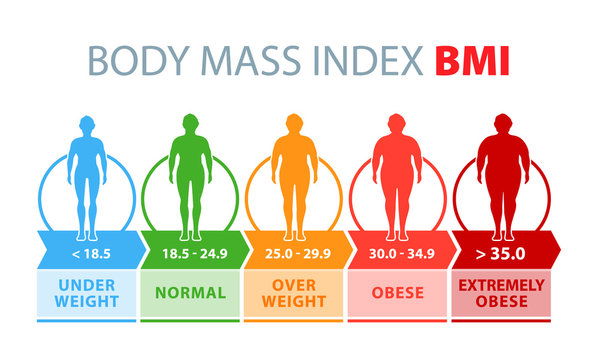Body Mass Index (BMI)

Body mass index is a value derived from the mass and height of a person. The BMI is defined as the body mass divided by the square of the body height, and is expressed in units of kg/m², resulting from mass in kilograms and height in metres
BMI Categories:
Underweight = <18.5
Normal weight = 18.5–24.9
Overweight = 25–29.9
Obesity = BMI of 30 or greater
How do I calculate my BMI?
Body Mass Index is a simple calculation using a person's height and weight.
The formula is
BMI = kg/m2
where kg is a person's weight in kilograms
and m2 is their height in metres squared.
A BMI of 25.0 or more is overweight, while the healthy range is 18.5 to 24.9.
BMI applies to most adults 18-65 years.
What is a normal BMI?
a) If your BMI is 18.5 to 24.9, it falls within the normal or Healthy Weight range.
b) If your BMI is 25.0 to 29.9, it falls within the overweight range.
c) If your BMI is 30.0 or higher, it falls within the obese range.
The BMI ranges are based on the relationship between body weight and disease and death.
Overweight and obese individuals are at an increased risk for the following diseases:
- Coronary artery disease
- Dyslipidemia
- Type 2 diabetes
- Gallbladder disease
- Hypertension
- Osteoarthritis
- Sleep apnea
- Stroke
- Infertility
- At least 10 cancers, including endometrial, breast, and colon cancer
- Epidural lipomatosis
Among people who have never smoked, overweight/obesity is associated with 51% increase in mortality compared with people who have always been a normal weight.
Applications of BMI Index
What Next? Take Action Towards Better Health:
- Maintaining a healthy weight is important for your heart health.
- Learn more about Overweight and Obesity.
- Increase Physical Activity
- Moving more can lower your risk factors for heart disease.
Diet
- Eating a healthy diet is the key to heart disease prevention.
- know and control your Health Numbers.
- Tracking your heart health stats can help you meet your heart health goals.
Eat Right
To lose weight, it's important to make lifestyle changes with a focus on reducing calories from food and beverages, a healthy eating plan, and portion control.
This section will provide you with guidance and tools on how to eat right. Over time, these changes will become part of your everyday routine.
Why A Healthy Eating Plan
A healthy eating plan gives your body the nutrients it needs every day while staying within your daily calorie goal for weight loss.
A healthy eating plan also will lower your risk for heart disease and other health conditions.
A healthy eating plan:
- Emphasizes vegetables, fruits, whole grains, and fat-free or low-fat dairy products.
- Includes lean meats, poultry, fish, beans, eggs, and nuts
- Limits saturated and trans fats, sodium, and added sugars
- Controls portion sizes
Calories
To lose weight, most people need to reduce the number of calories they get from food and beverages (energy IN) and increase their physical activity (energy OUT).
For a weight loss of 1–1 ½ pounds per week, daily intake should be reduced by 500 to 750 calories.
In general:
- Eating plans that contain 1,200–1,500 calories each day will help most women lose weight safely.
- Eating plans that contain 1,500–1,800 calories each day are suitable for men and for women who weigh more or who exercise regularly.
Very low calorie diets of fewer than 800 calories per day should not be used unless you are being monitored by your doctor.
Menus
A variety of reduced-calorie daily menus are provided to help make it easier for you to eat right and lose weight. The sample menus include ideas for traditional American meals as well as ethnic and vegetarian meals.
Traditional American Cuisine


